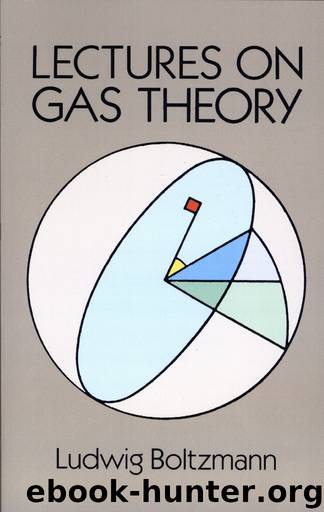Lectures on Gas Theory by Ludwig Boltzmann

Author:Ludwig Boltzmann [Ludwig Boltzmann]
Language: eng
Format: epub, pdf
Publisher: Dover Publications, Inc.
Published: 2014-03-14T16:00:00+00:00
§17.Geometric representation of the states in which two phases coexist.
If in the future we always mean by GHJ a line parallel to the abscissa axis, for which the two shaded areas are equal, then the results concerning the behavior of a substance under isothermal compression at a temperature τ3 can be expressed as follows. As long as the volume is greater than OE1 it is in the vapor state. If the volume is between OE1 and OG1, the liquid phase still cannot coexist with the vapor phase. Condensation can occur only when a salt, or rather a body whose particles attract the particles of the substance more strongly than they attract each other, is present. The liquid thereby formed will dissolve the salt or cover the body, and, if an infinite amount is not present, the vapor pressure drops as this process continues (premature condensation). If no such body is present, the substance will remain gaseous until its volume becomes equal to OG1. Here, if it is brought into contact with the least amount of the same substance in the liquid state, further isothermal compression causes condensation, and the vapor pressure does not increase until all of the substance has liquefied, since vapor of a higher pressure cannot exist over the liquid phase (normal condensation). If no body is present to facilitate normal condensation, then the substance can be still further compressed without condensation, so that its states are represented by the curved line GD (under-cooled vapor). However, if condensation sets in—which must happen in any case if the volume becomes less than OD1—then a finite amount of the substance suddenly liquefies, and the pressure drops to the value GG1 if the temperature is held constant. The substance behaves in a similar way if it is initially liquid and is gradually expanded; instead of bringing a small amount of liquid in contact with the vapor, one now creates in the liquid an empty or vapor-filled cavity.
We must omit from each isotherm the section CHD, since it corresponds to states that cannot be physically realized. Moreover, we shall consider neither delayed evaporation (superheating) nor undercooled or prematurely condensed vapor, but only normal condensation, which represents the directly reversible transition from the liquid to the vapor state. We then have to retain only the parts MJ and GL for each isotherm, in Figure 2. In the intermediate region one part of the substance will be liquid, in a state represented by the point J, while the other will be gaseous, in the state (?, both parts being at the same temperature and pressure. Each such intermediate state can be represented by the two points G and J simultaneously, each point having a weight corresponding to the fraction of the substance in that state. It is preferable to represent these states by different points on the line JG (the two-phase line). The ordinate NN1 (Fig. 2) of an arbitrary point N on this line represents the pressure, which is the same for both coexisting phases.
Download
This site does not store any files on its server. We only index and link to content provided by other sites. Please contact the content providers to delete copyright contents if any and email us, we'll remove relevant links or contents immediately.
The Complete Stick Figure Physics Tutorials by Allen Sarah(7339)
Secrets of Antigravity Propulsion: Tesla, UFOs, and Classified Aerospace Technology by Ph.D. Paul A. Laviolette(5336)
Thing Explainer by Randall Munroe(3911)
The River of Consciousness by Oliver Sacks(3574)
The Order of Time by Carlo Rovelli(3164)
How To by Randall Munroe(3078)
A Brief History of Time by Stephen Hawking(2994)
I Live in the Future & Here's How It Works by Nick Bilton(2963)
What If?: Serious Scientific Answers to Absurd Hypothetical Questions by Randall Munroe(2670)
The Great Unknown by Marcus du Sautoy(2664)
Midnight in Chernobyl by Adam Higginbotham(2519)
Blockchain: Ultimate Step By Step Guide To Understanding Blockchain Technology, Bitcoin Creation, and the future of Money (Novice to Expert) by Keizer Söze(2467)
Networks: An Introduction by Newman Mark(2383)
The Meaning of it All by Richard Feynman(2320)
Easy Electronics by Charles Platt(2310)
The Tao of Physics by Fritjof Capra(2247)
Midnight in Chernobyl: The Untold Story of the World's Greatest Nuclear Disaster by Adam Higginbotham(2200)
Introducing Relativity by Bruce Bassett(2098)
When by Daniel H Pink(2098)
